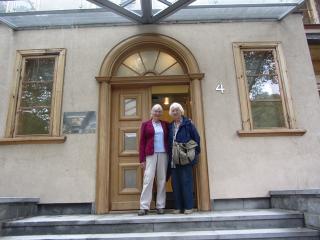History of the building and the Sporleder's family
The building of the Embassy of the Czech Republic was built in 1928 by Ernst Sporleder and his son Ernst Conrad Sporleder, the owners of E. Sporleder Ltd. who lived there with their families until 1940.
The building was nationalized in December 1940 by the soviet government. During the Nazi occupation 1941 – 1944 a German admiral lived there. Since 1945 until 1994 was the building owned by the state and used as an apartment house. The building was renovated in 1969 and separated into 6 housing units.
Villa was given in restitution back to the inheritors of Ernst Sporleder Jr. - Vera Sporleder-Milan (living in Canada) and Maria Bose-Sporleder (living in Freiburg, Germany), who then sold the property to Estonian bank Krediidipank.
Ministry of Foreign Affairs bought the house in 2000 and renovated the building from top to bottom in 2003. The construction of the second building (residence) was carried out in 2004 by a Czech company Czasch (designed by Ing. arch. Jana Hemera, CSc, from company Pikaz).
The new building of the Embassy of the Czech Republic in Estonia was ceremonially open on 28th October 2004.
Grand-daughters of Ernst Sporledera Jr. – Vera Sporleder-Milan and Maria Bose-Sporleder visited Estonia in August 2016. One of the aim of the visit was the launch ceremony of the book “Viimases kohvris on kodumaa” (Motherland in a last suitcase) written by Maria Bose-Sporleder. She dedicated a whole chapter in her book to the current embassy building in Lahe 4 and her memories from summer of 1930, 1998 and 2011. With her kind consent we publish a translated version of the chapter. Both sisters also visited our embassy and met with the Deputy Head of mission Alena Teznerová.
Chapter Lahe 4 (1930, 1998 and 2011) from „Viimases kohvris on kodumaa“ a book by Maria Bosse-Sporleder
Dark brown oak door. Or is the exposition of the photo insufficient? Part of the door is half open, the depth of the cassette ceiling are clearly visible. My grandfather is leaning on the closed part of the door. With his hair almost white he’s standing still and calm by the entrance of his house. One leg stretched, the other bent in knee, his back leaning on the oak door.
He had both his hands in pockets. His vest is the same light grey fabric as his trousers and jacket. With the help of a magnifying glass I can see his iron chain that was given to him as a sign of gratitude for donating his golden necklace during the war of independence in 1919.
A young lady wearing a hat, a coat to her knees and white shoes is standing next to the entrance. She’s gracefully leaning on the doorframe: granddaughter Cathrin visiting from Canada.
The door is ajar slightly. Are they waiting for me today? They gladly let me in, I know that I have to go in to argue again with the Armenian tenant, who’s apparently an arms dealer, gangster and who is staring at me with his shining brown eyes and claims that his father, uncle and brother don’t live in this apartment. It’s just his three months old son and his mother, who is taking care of him. I have to sign in the child to the register and get a permit for his mother at the city government so that she can finally be granted a visa from Saint Petersburg. This is something I should be able to understand?
In the back, in my grandfather’s dining hall there is a massive dog the size of a small elephant wandering around. My worried question is left without a clear answer. He’s not doing anything until the owner calls him to order, just like now. He had no idea that he needed my approval if he wants to set up a satellite antenna on the top of the roof. The soviet municipal administration has never cared about things like that. Oh yes, and a cable from the roof to the house across the street was just a friendly agreement between the neighbours. Is it something to disapprove? The dog is still lying on the floor, staring at me constantly.
Closing the door from outside I stop for a moment: there is no one to lean on the oak door anymore.
The door isn’t ajar this time. It was closed by the ambassador of the Czech Republic, who sent me out after the visit. We had espresso on the terrace before that, brewed by the ambassador himself as his wife wasn’t home. I’m looking at the garden founded by my grandfather. There is a small pond in front of the 80 years old gazebo, the water is babbling. We talked in English about international politics, Czech and Estonian Republics and finally about the building. Our current host told me that his predecessor who bought the house was exceptionally attracted to it. He had the old mouldered building torn down and build a precise replica in place of the old one.
The ambassador showed me around the building. Now we are standing in front of the oak door. Someone is taking a photo. The ambassador has put his left hand in the pocket of his trousers, his right hand with a cigarette hanging crestfallen. I have crossed my arms on my white jacket on the photo. Apparently, in consent.







Follow us on